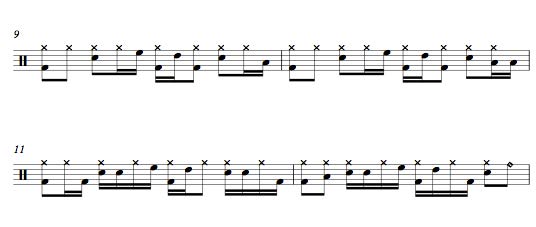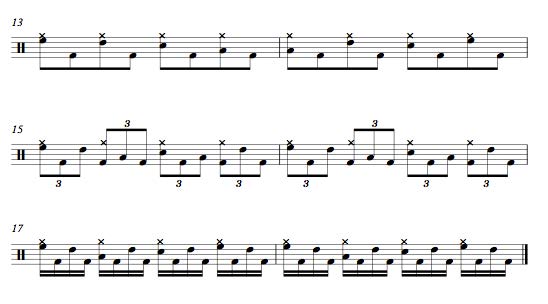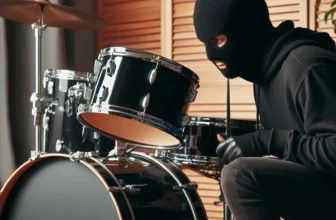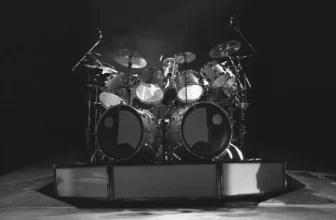Open-Handed Drumming: How to Play and Benefits


It wasn’t until the Summer of 2009 that I saw what open-handed drumming was all about. Up to that point, I’d seen drummers only dabble in it. So when I saw gospel artist Israel Houghton play at an outdoor festival in the UK, I saw how open-handed playing could fling a whole world of possibilities.
And I felt depressed.
Because when I watched that drummer flow through linear grooves and linear fills as smooth — and unstoppable — as water over rock, I thought I’d never get to that level.
It was initially discouraging because I’d been at music college for a few years. I’d worked pretty hard, and I felt like the guy who reaches the summit of a mountain only to be told he’s only made it to base camp!
Okay, so I don’t want to be overdramatic here; I got over it pretty quickly, but it was still a reality check, if nothing else.
A few years later, I’d just finished playing a gig in Central London when someone came up to me and said:
“Hey, I noticed you playing the left hand on the hi-hat today, and it looked like you could do loads of different things with that. At first, I just thought you were showing off!”
I’m not some top-tier gospel chops guy, but I felt that I’d at least managed to get open-handed playing into my toolbox. Now I swear by it.
Not so long ago, I heard a top drum educator say they’d teach their kids how to play drums open-handed from the very start because of all the benefits involved.
I don’t know if I’d go that far myself, but I do know that there’s so much potential in open-handed drumming, and — in my opinion — you don’t want to miss out.
In this article, I will tell you why; and share a few ways to get your open-handed playing up to snuff.
What Is Open-Handed Drumming?
Open-handed playing is simply using the left hand on the hi-hat and the right hand on the snare (or anywhere else on the kit).
Now, before I continue, let me give a little disclaimer:
I’m writing this article as a right-handed drummer, and I’m working on the assumption that most people are right-handed drummers.
If you’re a left-handed drummer, please forgive me, and switch the ‘rights’ and the ‘lefts’ around, as appropriate! Now I’ve said it, let’s get back to business.
Playing the hi-hat with your ‘weaker’ hand may seem strange; this whole article might seem like a great big fuss over nothing, but before we reach that conclusion, let’s embark on a little experiment.
Sit behind the kit, and put your left stick on the hi-hat and your right on the snare. Go ahead. Indulge me for a moment.
If you’ve just gone and done that (or if you can, for a moment, imagine that you have), you’ll have noticed that when the left hand rests on the hi-hat, the right hand is free to play the whole kit with ease.
When you play the drums closed-handed, your left hand can stretch across to the hi tom now and then, or it can find its way across to the middle tom. However, going beyond that to play the floor tom as part of a groove is pretty tough. It’s not impossible, for sure, but it doesn’t feel natural to most of us.
When you play open-handed, the whole kit becomes easily accessible to you, drastically increasing the range of options you have at your disposal.
Grooves can then include all kinds of voices with the utmost ease, and fills can snake their seamless way through your playing without any hindrance.
Three More Benefits to Open-Handed Playing
Many drummers spend a long time trying to become ambidextrous. Ideally, we want to have high creative freedom and technical control over all four limbs. Open-handed playing can help with this.
When you start to develop your playing this way, your left hand has to grow in stamina and power to keep the hi-hat ticking over consistently. Using an open-handed Moeller stroke on the hi-hat will help you develop control with that arm.
Playing the same groove open and close-handed means that both arms are becoming equally capable. This inevitably leads to a knock-on improvement in your fills, grooves, and solos — you’ll notice this spreading through all of your playing.
Open-handed playing looks pretty cool when you get comfortable with it, and that’s no small thing. Musical performance often draws on the visual and the audible — like all in-person communication, body language, and facial expressions form an essential part of the message.
Finally, open-handed playing will free up your strong hand so you can finally thwack the bassist mid-gig!
(*Ahem*… I’m kidding… obviously…)
Joking aside, there are many other benefits to open-handed playing, and you’ll no doubt discover these as you get stuck in. If I’ve managed to convince you, let’s look at how you can start with open-handed drumming.
How To Learn Open-Handed Drumming
We’ll look at a few playing exercises in just a moment, but before we do, we ought to start by saying this: the best place to start is at the beginning.
In practical terms, I’d encourage you to begin with the first groove you ever learned to play. Perhaps that means starting here:

I won’t write out all of the obvious grooves drummers start by learning, but needless to say: I’d recommend starting simple and then working your way up.
I’d recommend adding a few kick drums here and there before progressing onto snare and kick independence.
After that, you can add open hi-hats, ghost strokes, and drags on the snare with your right hand. (Don’t forget: I’m writing as a right-handed player — if you’re a leftie, flip the script!)
If you’re a pretty advanced player, it might feel frustrating to start this way but don’t rush. The more patient you are, the quicker you’ll get comfortable and the less frustrated you’ll feel as you work everything out.
Playing open-handed is confusing at first, so go slow. Take time to figure out where in the bar each hand should go and how everything fits together.
A More Advanced Open-Handed Exercise
While you explore playing old grooves in a new way, try the exercise below to help you build further independence.

We’re playing something like a single-stroke roll between the right hand and the right foot, while the left hand keeps the hi-hat going.
Again, don’t rush. This is a tricky exercise. When you’ve built up the speed a little, we can start orchestrating the right hand around the kit.
By the way: when you’re playing the third line of the exercise, you may notice that the floor tom and kick drum sounds somewhat like a double kick groove (especially if the floor and kick are tuned to complement each other in this way, or you use slight dampening on the floor tom).
Orchestrating the Right Hand
As you get more comfortable with open-handed playing, you can reap the benefits of the stance. Below are a couple of orchestrated snare independence grooves.
Do you see that ride bell at the end of line two? Be sure to play it with the right hand (presuming your ride sits on the right side of your kit).

Next, let’s turn our attention to an orchestrated version of the previously seen ‘advanced exercise.’
Notice how this exercise could form the basis for an exciting groove but how it could also be used to build some interesting fills.

As you work through these exercises, try to hear the possibilities at every turn. You’ll find various ways to explore different levels of independence and orchestration, but also dynamic variation and multiple articulations.
Famous Drummers Who Play Open-Handed
Some big-name drummers who exclusively play open-handed while drumming include:
- Simon Phillips (Toto, The Who, Jeff Beck, Hiromi)
- Billy Cobham (Mahavishnu Orchestra, Miles Davis)
- Dom Famularo
- Gary Husband (Allan Holdsworth, Level 42)
- Mike Mangini (Dream Theater)
- Carter Beauford (Dave Mathews Band)
- Robert “Sput” Searight (Snarky Puppy)
Wrapping it Up
So we’ve come to the end of our first look at open-handed playing. If this has caught your imagination, I will encourage you to practice the stance regularly. I wouldn’t recommend practicing open-handed playing exclusively — unless you intend to play this way all the time — but it would be a great idea to work it into a balanced diet of various drumming styles and techniques.
If you want a more in-depth look at open-handed drumming, take Drumeo’s lesson on Hand Technique: The Motions of Drumming.
I highly recommend Drumeo when it comes to learning drums online. Their program is by far the best way to learn more, regardless of your skill level (check my review of Drumeo here).
Oh, and by the way: don’t forget to throw some of your favorite tunes on and play along open-handed. Doing so can present a super-fun challenge, allowing you to ‘road test’ everything in a real-world playing scenario.
Don’t be put off by the challenge — open-handed playing can feel comfortable more quickly than you imagine.
If you work at it, you’ll soon see the payoff; and be really glad you got started. Next time, we’ll look at some intriguing ways to use open-handed playing to challenge ourselves and breathe new life into our grooves and fills. Until then — and, as always — happy drumming!





